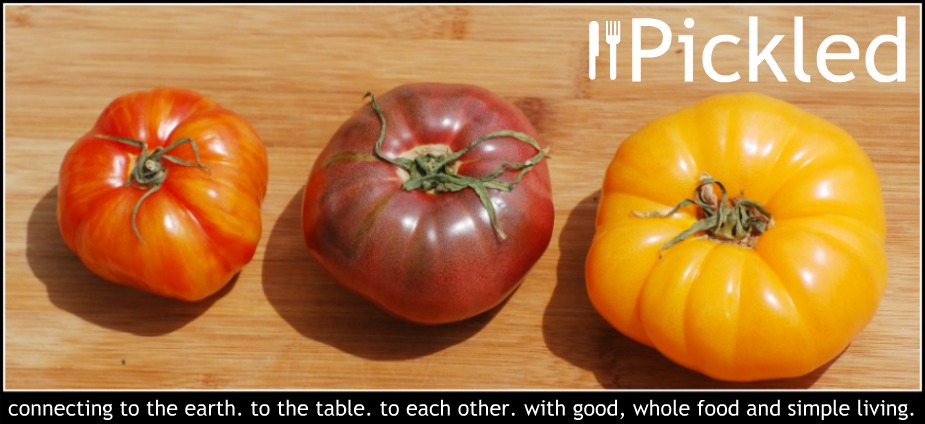 |
| Wakame (photo via) |
And you know what I need? No, not more cowbell (although that would definitely be my second choice). I need to get out in the pristine waters of the San Juans and harvest my own kelp. I have a trip planned to Lopez Island (Washington state) in less than 2 weeks and I’m itching like crazy to get in my kayak, to sit on the moving, cold pacific waters in the midst of ancient kelp beds and to just breathe the salty air. There is something extraordinary and transcendent about being in the presence of living seaweed and connecting to such a life-giving force.
For now, I’m fixing my itching by making Ginger Wakame Crisps (recipe below). Wakka what? Pronounced "wok-uh-may," this glorious sea treasure is a deep, richly green colored kelp (though actually in the brown algae family: Undaria pinnatifida).
Wakame is just one of many varieties of seaweed. You might have seen it in miso soup since it is traditional to Japanese cooking and culture.
What’s the big deal about seaweed?
Glad you asked. It’s a huge deal. It’s been prized and eaten for literally thousands of years as a powerful, sustainable, medicinal and tasty food source.
Here's why:
Here's why:
- Mineral density! Think of minerals when you think of seaweed. Seaweed contains ALL the minerals the body needs for hundreds of vital biochemical pathways that take place every single second: calcium for bone health and cell signaling; iodine and selenium for thyroid function; iron for oxygen transport and energy metabolism; sodium and potassium which are essential for electrolyte balance --- just to name a few!
- It’s an excellent detoxifier. Seaweed contains alginic acid, which has the remarkable ability to bind toxic heavy metals and other toxins (like dioxin) so they can be excreted and not absorbed by our tissues; heavy metal toxicity places an enormous burden on our bodies and is the source of a lot of dysfunction and dis-ease at the cellular level.
- Helps prevent cancer and tumor growth. For the reasons listed above, but especially for colon and estrogen-related cancers like breast cancer; however if a patient is undergoing chemo or radiation therapies, incorporating brown seaweeds into the diet are a must for ongoing support.
- It’s anti-viral, fighting off viruses that can penetrate and infect our DNA, like HIV and Herpes (both I and II).
- Great plant source of B vitamins, especially B12: important for everyone, but definitely vegans and vegetarians who have to be mindful about getting enough B12 in their diets.
There are just a few of my favorite therapeutic benefits, but also keep in mind that seaweed is a powerful antioxidant, rich in both phytonutrients and fucoidan compounds, additionally making consuming seaweed especially good for:
- Boosting the immune system
- Growth of shiny, healthy, hair, nails and skin
- Weight loss
- Heart health (as an anti-coagulant)
- Controlling blood sugar and lowering the risk of Type II Diabetes
- Quelling inflammatory conditions in the body (your guts, your joints)
Who wouldn’t want those benefits? Let me assure you that as much as I love the medicinal profile of seaweed, I would not make a whole dish out of it if it didn’t taste good!
I challenge you to go to your natural foods market (or visit Eden Foods) to purchase dried wakame and make this dish. You may be completely surprised by how easy it is to toss back a handful of this crispy, subtly sweet, salty treat. If you aren’t feeling quite so bold but really want the medicinal benefits of seaweed, stay tuned for the next post on seaweed for a tip that makes eating seaweed easy for any palette. If you have a sensitive gut, it’s not a bad idea to start slow to allow your body time to assimilate a new food.
And finally, I wrote up this recipe a few months back and am dedicating it to one of my dearest friends, Siona. Within a week of first meeting her a couple years ago, she shared this pearl, this gospel of good news, this thing called, kombu: seaweed. I was in awe. And I remember the exact moment of this first introduction because it was a gift of knowledge that had been imparted, that resonated with my passion for whole food and food as medicine. We were taking a walk near Waverly Beach Park in Kirkland, WA as we admired the beauty of the lake and the glimpse of the space needle in the distance. Since then, I have harvested it myself, researched in depth the many varieties, nutritional and medicinal properties and cook with it several times a week in my home. This friend and I marvel together over our love for this sea treasure, just as much as we marvel over rich, creamy, full-fat, good, quality ice cream.
For some, seaweed or sea vegetables is nothing new. You’ve had sushi wrapped in nori, or miso soup with shreds of wakame in it, but for many Americans, seaweed is not a part of our regular diets.
It should be.
I am so grateful for gaining a deeper understanding of this powerful food and so now I impart this to you!
 |
| 1/2 cup of dried wakame (right) with same amount hydrated (left) |
There are numerous varieties with a range of flavor profiles, so try a few different kinds and see what you like. …more on seaweed harvesting, sustainability and ways to use seaweed everyday in a future post.
Any seaweed questions, post ‘em up! Whose got a fever?
Ginger Wakame Crisps
__________________________________________________________________
I made these mineral-rich, ginger and sesame-spiced seaweed snacks in honor of one of my dearest friends, Siona Sammartino, who lives, breathes and dreams seaweed! There is a lovely little restaurant called Nettletown that is nestled away in the Eastlake area of Seattle; it happens to be one of our favorite places to frequent especially because of the crispy seaweed appetizer on the menu. You can serve this as a unique and tasty appetizer, a topping for salads, Asian noodle dishes or simply enjoy it as a salty snack.
Preparation time: 40 minutes
Serves 4
½ cup dried wakame
¼ cup coarse grated ginger root
2 tablespoons toasted sesame oil
1 teaspoon tamari
1 teaspoon brown rice vinegar
Pinch of white pepper (optional)
Pre-heat oven to 350°F.
To re-hydrate wakame, place it in a medium size bowl and cover with plenty of water for. Let the seaweed set for 5-10 minutes while you prepare the dressing. It will grow at least 5 times in volume.
In a small bowl, squeeze the juice from the grated ginger using your hand to wring out every last bit. Discard the pulp. Add the oil, tamari, vinegar, white pepper and stir.
Drain the wakame and a use a towel to gently blot the seaweed to soak up as much water as possible. Pour the liquid mixture over the hydrated seaweed and carefully toss to coat. Spread half of the wakame on a large baking sheet making sure to not leave clumps so the heat can circulate and make them nice and crispy. Bake for 15-17 minutes, or until the seaweed crisps up. Use a spatula to remove the wakame crisps from the pan and place on a plate lined with paper towels. Repeat for the remaining half of seaweed. Enjoy!
Copyright 2011, S. Nester, Original recipe
_____________________________________________________________________________
***Note: If you have a hyperactive thyroid or are concerned about iodine content in seaweed, talk with your physician before consuming seaweed on a regular basis. Wakame specifically contains 50-150ppm of iodine.
Sources:












